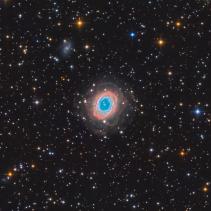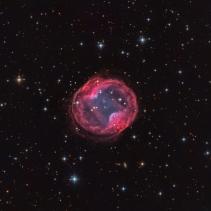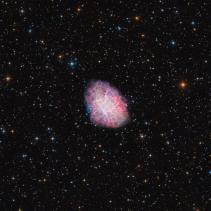Nebulas
Abell 39
Abell 39 is a low surface brightness planetary nebula in the constellation of Hercules. It is the 39th entry in George Abell's 1966 Abell Catalog of Planetary Nebulae (and 27th in his 1955 catalog) of 86 old planetary nebulae which either Abell or Albert George Wilson discovered before August 1955 as part of the National Geographic Society - Palomar Observatory Sky Survey.[4][6] It is estimated to be about 6,800 light-years from earth and 4,600 light-years above the Galactic plane. It is almost perfectly spherical and also one of the largest known spheres with a radius of about 2.5 light-years.
Its central star is slightly west of center by about 2″ or 0.1 light-years. This offset does not appear to be due to interaction with the interstellar medium, but instead, it is hypothesized that a small asymmetric mass ejection has accelerated the central star. The mass of the central star is estimated to be about 0.61 M☉ with the material in the planetary nebula comprising an additional 0.6 M☉.
This planetary nebula has a nearly uniform spherical shell. However, the eastern limb of the nebula is 50% more luminous than the western limb. Additionally, irregularities in the surface brightness are seen across the face of the shell. The source of the east-west asymmetry is not known but it could be related to the offset of the central star.
The central star is classified as a subdwarf O star.
Ha = 11 * 1200 sec, OIII = 14 * 1200 sec, bin1.
Total exposition - 8 hours.
Pixinsight 1.8, Lightroom.
M 57
The Ring Nebula (also catalogued as Messier 57, M57 or NGC 6720) is a planetary nebula in the northern constellation of Lyra. Such objects are formed when a shell of ionized gas is expelled into the surrounding interstellar medium by a red giant star, which was passing through the last stage in its evolution before becoming a white dwarf.
This nebula was discovered by the French astronomer Antoine Darquier de Pellepoix in January 1779, who reported that it was "...as large as Jupiter and resembles a planet which is fading". Later the same month, fellow French astronomer Charles Messier independently found the same nebula while searching for comets. It was then entered into his catalogue as the 57th object. Messier and German-born astronomer William Herschel speculated that the nebula was formed by multiple faint stars that were unresolvable with his telescope.
L = 18 * 1800 sec. bin1, R = 12 * 700 sec. bin2, G = 12 * 840 sec. bin2, B = 12 * 980 sec. bin2, HaOIII = 10 * 1800 sec. bin2, in the each filters.
Total exposition - 27.4 hours.
Pixinsight 1.8, Lightroom.
PK 164+31.1 LRGB+HaOIIISII
ones-Emberson 1 (PK 164+31.1) is a 14th magnitude planetary nebula in the constellation Lynx at a distance of 1600 light years. It is a larger planetary with low surface brightness. The 16.8-magnitude central star is a very blue white dwarf.
Discovered in 1939 by R. Jones and R. Emberson, it's "PK" designation comes from the names of Czechoslovakian astronomers Luboš Perek and Luboš Kohoutek, who in 1967 created an extensive catalog of all of the planetary nebulae known in the Milky Way as of 1964. The numbers indicate the position of the object on the sky. ("PK 164+31.1" basically represents the planetary nebula that when using the galactic coordinate system has a galactic longitude of 164 degrees, a galactic latitude of +31 degrees, and is the first such object in the Perek-Kohoutek catalog to occupy that particular one square degree area of sky).
L = 14 * 1800 sec. bin1, RGB = 10 * 900 sec. bin2, Ha - 18*1800 sec., OIII - 15*1800 sec., SII - 17*1800 sec., bin2, in the each filters
Total exposition - 39,5 hours
Pixinsight 1.8, Photoshop.
M 1
The Crab Nebula (catalogue designations M1, NGC 1952, Taurus A) is a supernova remnant and pulsar wind nebula in the constellation of Taurus. The now-current name is due to William Parsons, 3rd Earl of Rosse, who observed the object in 1840 using a 36-inch telescope and produced a drawing that looked somewhat like a crab. Corresponding to a bright supernova recorded by Chinese astronomers in 1054, the nebula was observed later by English astronomer John Bevis in 1731. The nebula was the first astronomical object identified with a historical supernova explosion.
At an apparent magnitude of 8.4, comparable to that of Saturn's moon Titan, it is not visible to the naked eye but can be made out using binoculars under favourable conditions. The nebula lies in the Perseus Arm of the Milky Way galaxy, at a distance of about 2.0 kiloparsecs (6,500 ly) from Earth. It has a diameter of 3.4 parsecs (11 ly), corresponding to an apparent diameter of some 7 arcminutes, and is expanding at a rate of about 1,500 kilometres per second (930 mi/s), or 0.5% of the speed of light.
L = 18 * 1200 sec. bin1, RGB = 10 * 900 sec. bin2, HaOIII = 12 * 1200 sec. bin2, in the each filters.
Total exposition - 21.5 hours




